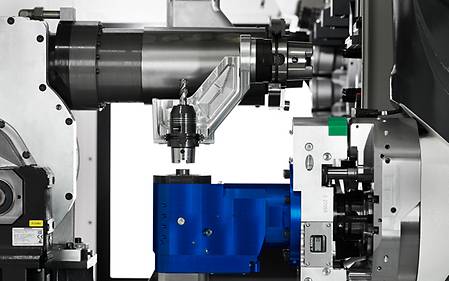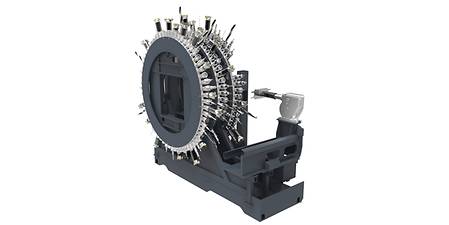Angle head innovation for green-button processes
DMG MORI and BENZ GmbH Werkzeugsysteme optimise production processes with an angle head that enables automatic changeover of front tools.

Angle heads have been state-of-the-art in the machining of complex parts for many years. They are used in particular for machining the inner parts of housing components in aircraft engines or stationary gas turbines, because it is often impossible for the main spindle to reach into the interior of the housing or to swivel in this position. Sophisticated workpieces made of materials that are hard to machine, such as titanium or nickel alloys, require the use of many different tools here as well as replacement tools due to the heavy wear. To date the changeover of tools in the angle head was either carried out manually while the machine was standing still, with the consequences for personnel costs and cycle times this involves, or by means of the automatic changeover of complete angle heads, that were either carried along or held ready on special pallets for each replacement tool. This results in high investment costs and a limitation of the system as a whole. In order to get around these uneconomical solutions, DMG MORI and BENZ GmbH Werkzeugsysteme have together developed an angle head for DMG MORI series machines that enables the automatic changeover of the front tools.
Low throughput times and the maximum achievable degree of unmanned production are the standard criteria for ensuring a high level of competitiveness in the world of machining. This is especially true in the fiercely competitive aerospace sector. “The so-called green-button process is being used increasingly in this branch for the machining of parts, a process in which manual intervention is no longer necessary”, explains Michael Kirbach, Head of the DMG MORI Aerospace Excellence Center. The challenge of integrating an angle head in this production process is all too familiar from numerous customer projects. “Our aim was to find a solution in which just the front tools could be automatically changed over in the angle head.” Customers of DMG MORI had also confirmed the need for such a solution in a survey. It was, however, a new project for a leading engine manufacturer that ultimately triggered the realisation.
Technological competence through development partnership
DMG MORI has found a competent technology partner in BENZ, for the development of an angle head that will meet today’s demands. The company from Haslach in Kinzigtal is one of the world’s leading manufacturers and suppliers of components and systems for tool and machine technology. BENZ was involved very early on in concept stage, to help test the feasibility of an angle head that could offer the required functionality. Andreas Motus, Technical Sales at BENZ, recalls the enquiry: “We already had the construction of just such an angle head filed away and had even implemented it, but due to a lack of available machine platforms we did not develop it further for DMG MORI series machines at that time. That all changed with the patented wheel magazine from DMG MORI. This magazine technology enables the accommodation of angle heads of the required size and weight as well as the front tools in a holder adapted to the respective angle head in the wheel magazine.
Normally machining centres from the duoBLOCK® or portal series are the mechanical basis for machining with angle heads at DMG MORI. “Mill/turn technology is usually used here, due to the rotationally symmetrical housing parts involved", Michael Kirbach goes on to tell us. The specific project with the new angle head therefore includes two DMC 125 FD duoBLOCK® centres and one DMU 210 FD. During the course of the intensive collaboration, BENZ gradually adapted the existing construction to the series machines. “First the changeable weight and the moment of tilt had to be adapted”, explains Andreas Motus. “We have also integrated the additional clamping elements in the angle head, in order to minimise any interfering contours on the machine spindle.” The angle head must ensure a reliable clamping of the front tools and this in turn requires hydraulic transfer from the spindle. BENZ has achieved this by means of special hydraulic couplings. The company has also found a way to transmit signals inductively instead of via separate plugs.
Interplay of tool changer, angle head and software

According to Andreas Motus the demands on repeat accuracy for tool changeover presented a great challenge during the development: “As a consequence the tolerances in the production of the angle head are correspondingly low. The interplay between the tool changer, angle head and software is also decisive, as Michael Kirbach adds: “The software regulates the procedure of the changeover process and the management of the angle head and the front tools including their holders, which remain in the tool wheel after changeover." The compatibility of the development with series machines is a key advantage: “Users can order a machine solution together with a proven angle head concept as an option and do not have to design any complicated special solution, which would limit the system as a whole.”
DMG MORI und BENZ appear more than satisfied with the outcome of the project. The result is a solution with which the machining centre can change the angle head and the front tools independently of each other and organise them in the tool magazine. This means users are in a position to produce the complex components in unmanned operation with just one angle head. First customers have already taken a look at the concept and have expressed great interest in the option. In Michael Kirbach’s opinion, the reasonable payback period is an especially convincing factor: “We will be presenting this solution to the broad public at the EMO in a DMC 160 FD.” This also pleases Andreas Motus: “It was an extremely extensive project in which the focus was always placed on the innovative technology and the cooperative relationship as partners.
Contact us for all issues related to DMG MORI technical press.
